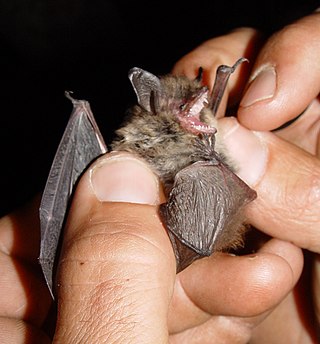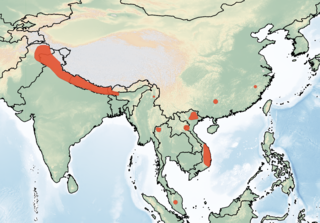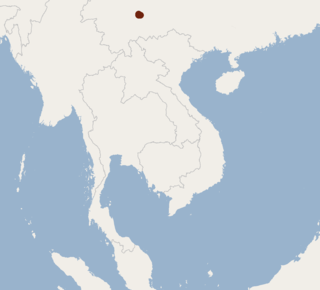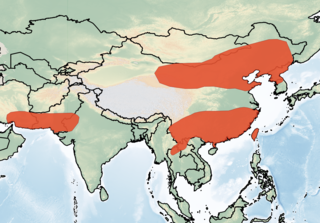
The mouse-eared bats or myotises are a diverse and widespread genus (Myotis) of bats within the family Vespertilionidae. The noun "myotis" itself is a Neo-Latin construction, from the Greek "muós and "oûs", literally translating to "mouse-eared".

The great evening bat is the largest bat in the vesper bat family (Vespertilionidae) and the only living species in the genus Ia. It is common to Eastern and Southeastern Asia, mainly living in areas with limestone caves at altitudes of 400–1,700 metres (0.25–1.06 mi). Their roost sites have been found both near the cave entrances and up to 1.5 kilometres (0.93 mi) within the cave systems.

Hodgson's bat, also called the copper-winged bat or black-and-orange myotis, is a species of vesper bat in the genus Myotis, the mouse-eared bats. Favouring mountain forests, it is found throughout Central, Southeast, and East Asia, from Afghanistan to Taiwan. It is about 5 centimetres (2.0 in) long and is distinguished from most other species of bat in this range by its yellowish colouration.

Hutton's tube-nosed bat is a species of vesper bat in the family Vespertilionidae. It can be found in the following countries: Bhutan, China, India, Laos, Malaysia, Myanmar, Nepal, Pakistan, Thailand, and Viet Nam. It lives within an elevation of 1450 m to 2500 m. In Southeast Asia, the bat is considered to be uncommon. The bat is known to live in forests, roosting among the leaves of banana trees. Its habitat is threatened by deforestation for firewood and timber, as well as conversion to agricultural land.

Cadorna's pipistrelle is a species of vesper bat in the family Vespertilionidae. It is found in India, Laos, Myanmar, Thailand, and Vietnam.

The fringed long-footed myotis is a species of vesper bat in the family Vespertilionidae. It is found in China, Taiwan and Hong Kong.

The Burmese whiskered myotis or Burmese whiskered bat is a species of vesper bat. It is found in China, India, Myanmar, Laos, and Vietnam.

The Annamit myotis is a species of mouse-eared bat in the family Vespertilionidae, described in 2001, and indigenous to the Minh Hóa Districton the northern coast of Vietnam. Following its description, investigators succeeded in locating M. annamiticus only in Phong Nha-Kẻ Bàng National Park, and the data regarding the distribution, population, and range of the species is otherwise inadequate to determine its conservation requirements. However it is protected by Phong Nha-Kẻ Bàng National Park.

The Bocharic myotis or Bokhara whiskered bat is a species of mouse-eared bat in the family Vespertilionidae, described in 1950, and indigenous to Tajikistan, and Uzbekistan.

The Nepal myotis is a vesper bat of genus Myotis.

The chestnut myotis is a species of mouse-eared bat in the family Vespertilionidae. It is found in South Asia.

Myotis indochinensis, commonly known as the Indochinese mouse-eared bat, is a species of cave-dwelling bat in the family Vespertilionidae. It is found in Vietnam and China.

The Oriental serotine is a species of bat in the family Vespertilionidae. It is widespread and found throughout Asia.

The orange-fingered myotis or red-painted myotis is a species of vesper bat endemic to the Philippines.

The reddish-black myotis or black-winged myotis, colloquially known as the "red bat" or "golden bat" in South Korea, is a species of vesper bat found throughout East Asia.
Weber's myotis is a species of vesper bat endemic to the Indonesian island of Sulawesi.

The Malaysian whiskered myotis or Malayan whiskered myotis is a species of vesper bat endemic to Malaysia, although it may possibly also occur in Indonesia.

The Bornean whiskered myotis is a species of vesper bat endemic to Borneo.
Strelkov's long-eared bat is a species of vesper bat found in mountainous regions of Central Asia.
Ward's long-eared bat is a species of vesper bat in the family Vespertilionidae. It is found in mountainous regions of South Asia and adjoining regions.

















